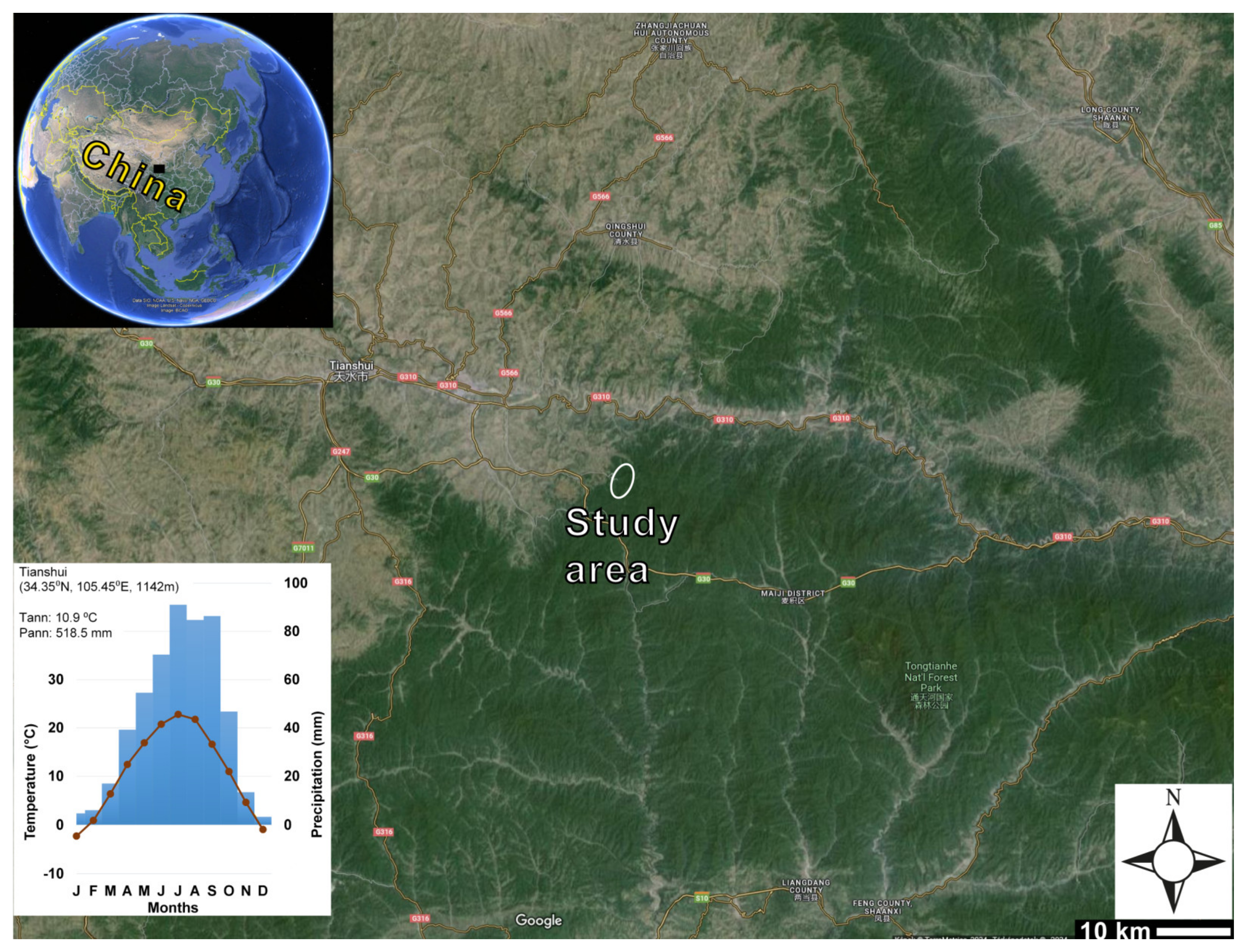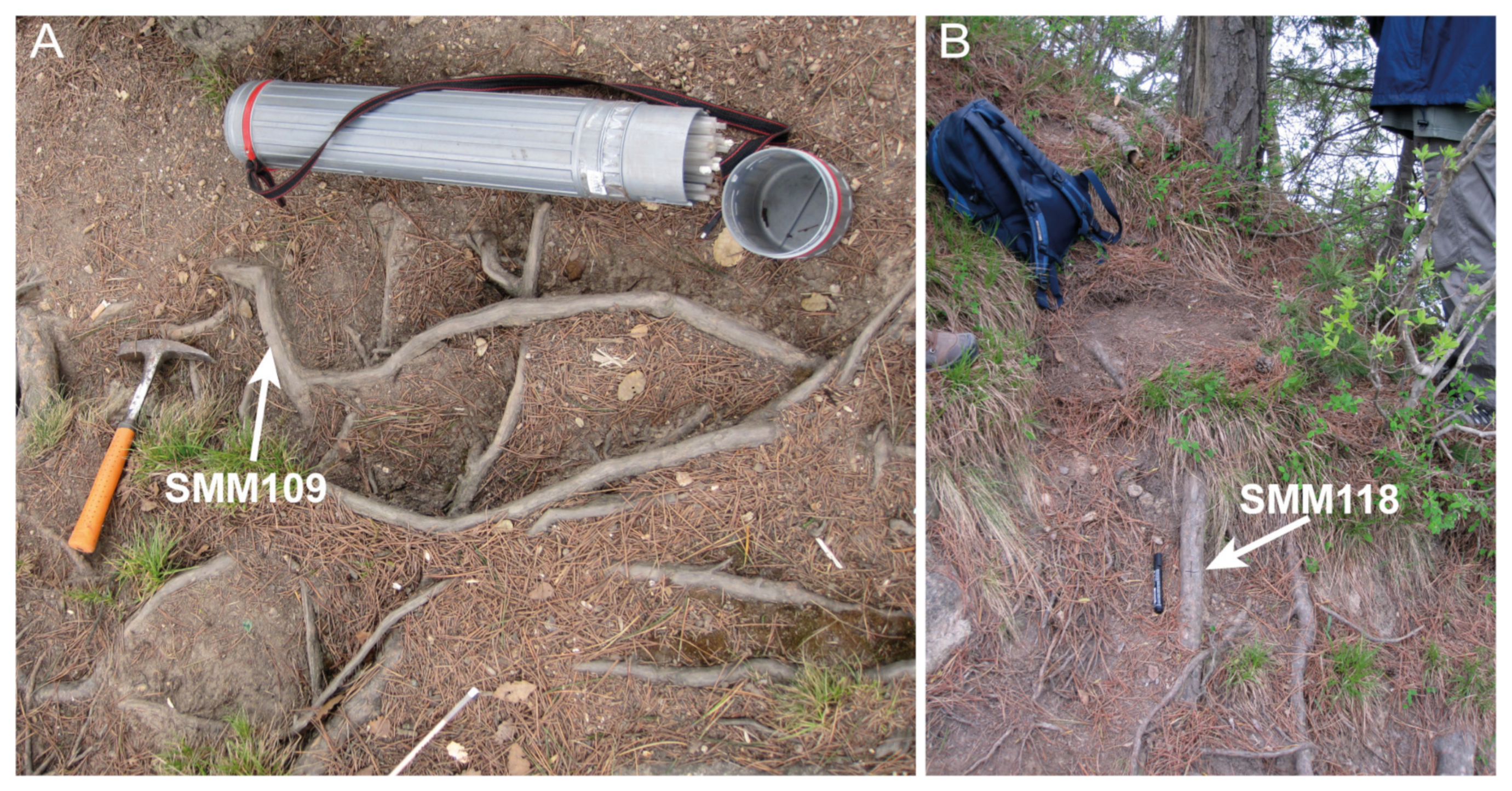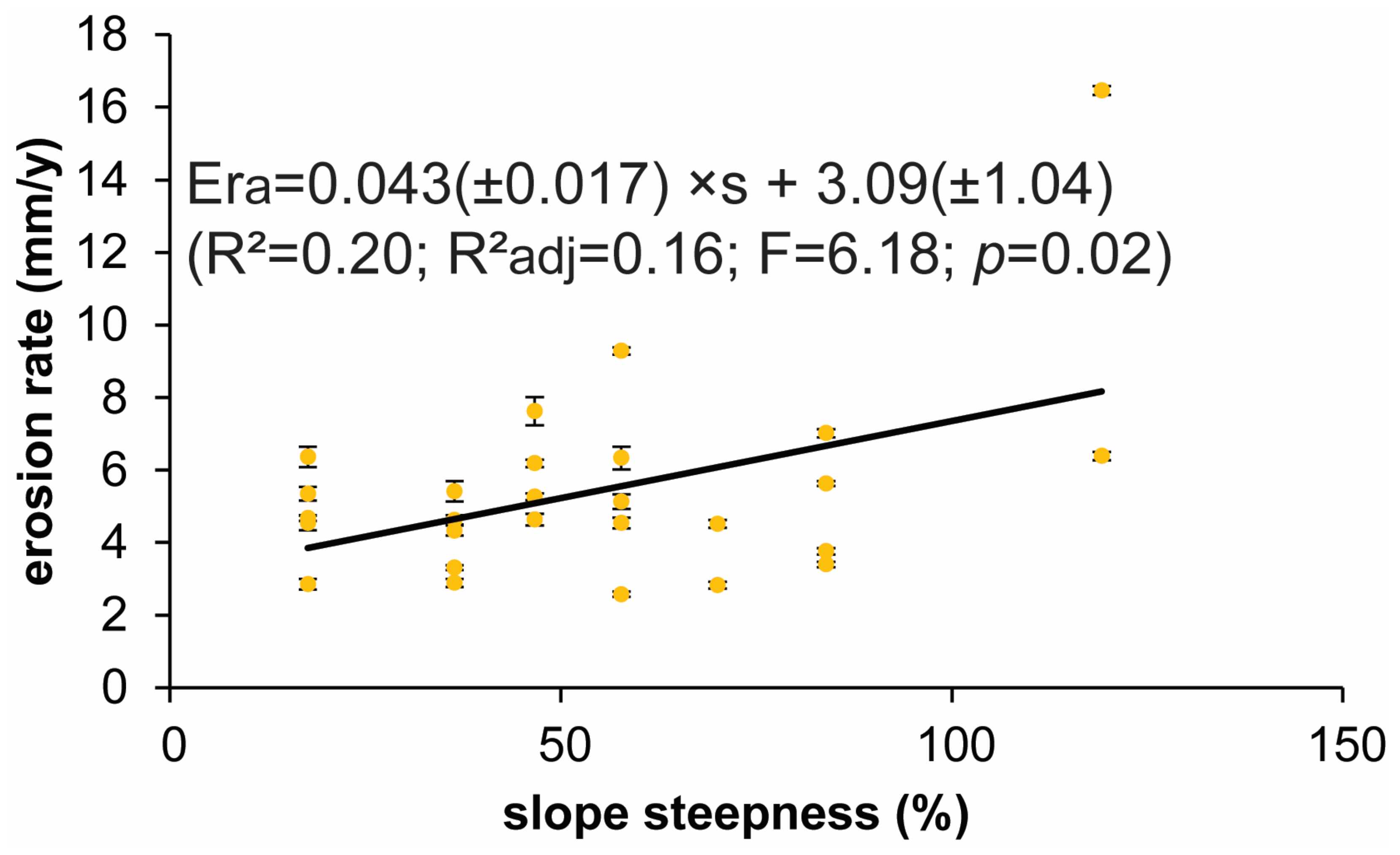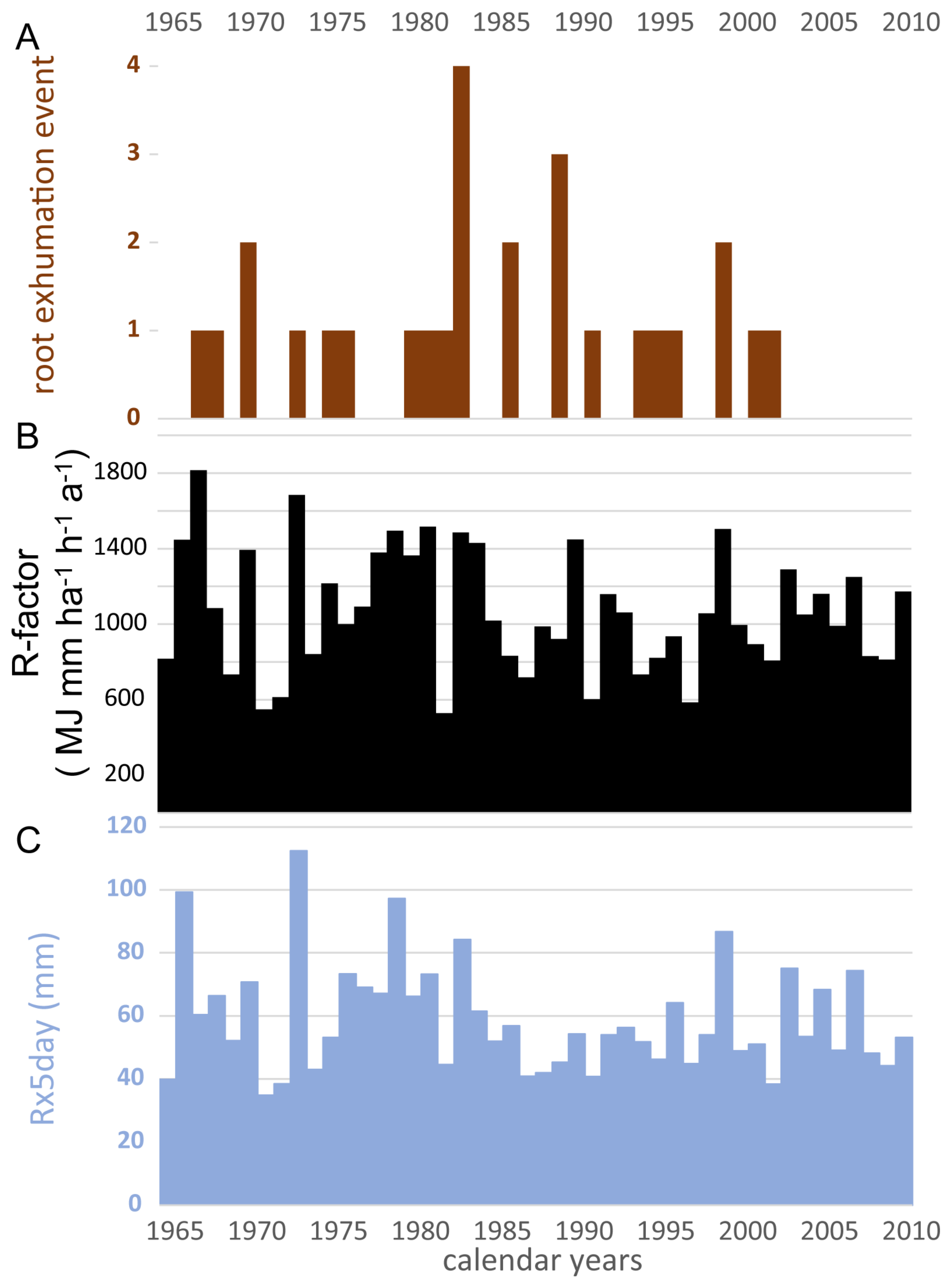Rapid Estimation of Soil Erosion Rate from Exhumed Roots (Xiaolong Mts, China)
Abstract
:1. Introduction
2. Materials and Methods
2.1. Site
2.2. Sampling and Measurements
2.2.1. Field Methods
- Roots overgrowing stones in the soil were not sampled: these cannot grow downwards, i.e., their pith possibly moves upwards due to growth in diameter [41].
- Ground surface was carefully cleared of leaf litter, taking care not to remove any soil.
- A cross was marked on the topmost portion of the root with indelible ink.
- A photo was taken for documentation (Figure 2).
- Azimuth and tilt of the slope were measured by a geological compass or by a simple compass and tiltmeter and rounded to the nearest 5°.
- Direction of the root was recorded relative to the dip of the slope (parallel, perpendicular, or oblique). We note that we found that exposed roots in all directions were useful in the soil erosion reconstruction despite the recommendation of [33], in the caption to his Figure 10).
- Height of the cross-marked top portion of the root above the homogeneous slope was measured on both sides [33] to the closest millimeter with the help of ruler and level or with a caliper; this measurement was always made in vertical direction (i.e., not perpendicularly to the slope, see Figure 3) and the average of the two values was used in calculations (see Section 2.3).
- Soil was removed from both sides and from below the root for easy access for sawing.
- A disk of ~20 to 50 mm thickness was sawed from the root (thickness was determined so as to allow the sample to be held easily by fingers during grinding and polishing, see Section 2.2.2).
2.2.2. Laboratory Methods
- Direction of the top marker (drawn in the field) was marked again on at least one face of the disk.
- Both faces were grinded on a belt sander using progressively finer grit sizes [46] beginning with P120 (~125 μm) and ultimately finishing with P400 (33.5–36.5 μm), which is usually enough for an almost polishing-level quality of the sanded face. Occasionally, in the case of very fine rings, we hand-sanded portions of the disk with a P800 (20.8–22.8 μm) sandpaper.
- Exhumation markers, both geometrical and textural [40], were identified (see Section 2.2.3) under the microscope and marked with pencil.
- The number of rings was counted from the outermost ring grown during the year of sampling towards the pith and calendar years were assigned. The outermost ring in this case was incomplete since sampling was carried out in the growing season. The rings were checked over the entire transect to also account for the frequently observed wedging rings.
- Calendar years were assigned to exhumation markers.
- Distance between pith and the top of the sample was measured to the nearest 0.5 mm using a ruler or a caliper (Figure 3). Independent measurements of this parameter were performed to characterize the uncertainty of the laboratory measurements (see Appendix A).
- Distance between the first exhumation marker and the top of the sample was similarly measured to the nearest 0.5 mm using a ruler or a caliper (Figure 3).
2.2.3. Exhumation Markers in Conifers
- Change from root texture to stem texture (Figure 4A). Soil-covered roots are largely protected from frost and drought. The reduced environmental signals mostly yield uniformly sized cell lumina and thin walls in the earlywood of conifer roots. Latewood is often a single row of cells only. Exposure to aboveground conditions usually yields smaller cell lumina and thicker cell walls, both in the earlywood and in the latewood. In macroscopic view, this change is displayed as lighter belowground and darker aboveground rings. Latewood is particularly affected by aboveground conditions: it is significantly thicker than the underground latewood. In short: roots produce xylem similar to that of stems after exposure to aboveground conditions [47].
- Reaction wood is formed in the wood under mechanical stress. Conifers’ reaction wood has wider rings than normal. The first ring with reaction wood dates the exhumation of the root. Multiple tilting events in the same stem may be recognized by changes in—among others—orientation of compression wood [33].
- Wounds (Figure 4C) are caused by injury to the root by mechanical means, mostly above ground, rarely below ground. If the cambium is damaged and suffers dieback, growth is stopped at that place, bark falls off, and an open wound is formed.
- Phenolic staining (by dark, reddish-brown compounds) adjacent to the wound (Figure 4C). These precipitates isolate the open wound from infection by bacteria and fungi. External surface of the stain is parallel with a ring—this is the year when the injury occurred.
2.3. Calculations and Evaluation
3. Results and Discussion
3.1. Rate and Time of Erosion
3.2. Coincidence between Wet Summers and Root-Based Erosion Events in the Xiaolong Mts between 1967 and 2002
3.3. Microscopic versus Macroscopic Analysis
4. Conclusions
Supplementary Materials
Author Contributions
Funding
Data Availability Statement
Acknowledgments
Conflicts of Interest
Appendix A

References
- Verheijen, F.G.A.; Jones, R.J.A.; Rickson, R.J.; Smith, C.J. Tolerable versus actual soil erosion rates in Europe. Earth-Sci. Rev. 2009, 94, 23–38. [Google Scholar] [CrossRef]
- Keesstra, S.; Mol, G.; De Leeuw, J.; Okx, J.; Molenaar, C.; De Cleen, M.; Visser, S. Soil-Related Sustainable Development Goals: Four Concepts to Make Land Degradation Neutrality and Restoration Work. Land 2018, 7, 133. [Google Scholar] [CrossRef]
- Liu, B.; Xie, Y.; Li, Z.; Liang, Y.; Zhang, W.; Fu, S.; Yin, S.; Wei, X.; Zhang, K.; Wang, Z.; et al. The assessment of soil loss by water erosion in China. Int. Soil Water Conserv. Res. 2020, 8, 430–439. [Google Scholar] [CrossRef]
- Fu, B.; Wang, S.; Liu, Y.; Liu, J.; Liang, W.; Miao, C. Hydrogeomorphic Ecosystem Responses to Natural and Anthropogenic Changes in the Loess Plateau of China. Annu. Rev. Earth Planet. Sci. 2017, 45, 223–243. [Google Scholar] [CrossRef]
- Sun, J.; Zhang, N.; Shi, M.; Zhai, Y.; Wu, F. The effects of tillage induced surface roughness, slope and discharge rate on soil detachment by concentrated flow: An experimental study. Hydrol. Process. 2021, 35, e14261. [Google Scholar] [CrossRef]
- Zhao, J.; Wang, Z.; Dong, Y.; Yang, Z.; Govers, G. How soil erosion and runoff are related to land use, topography and annual precipitation: Insights from a meta-analysis of erosion plots in China. Sci. Total Environ. 2022, 802, 149665. [Google Scholar] [CrossRef] [PubMed]
- Nearing, M.A.; Bradford, J.M. Single Waterdrop Splash Detachment and Mechanical Properties of Soils. Soil Sci. Soc. Am. J. 1985, 49, 547–552. [Google Scholar] [CrossRef]
- Van Dijk, A.I.J.M.; Bruijnzeel, L.A.; Eisma, E.H. A methodology to study rain splash and wash processes under natural rainfall. Hydrol. Process. 2003, 17, 153–167. [Google Scholar] [CrossRef]
- Nanko, K.; Mizugaki, S.; Onda, Y. Estimation of soil splash detachment rates on the forest floor of an unmanaged Japanese cypress plantation based on field measurements of throughfall drop sizes and velocities. CATENA 2008, 72, 348–361. [Google Scholar] [CrossRef]
- Szabó, J.A.; Centeri, C.; Keller, B.; Hatvani, I.G.; Szalai, Z.; Dobos, E.; Jakab, G. The Use of Various Rainfall Simulators in the Determination of the Driving Forces of Changes in Sediment Concentration and Clay Enrichment. Water 2020, 12, 2856. [Google Scholar] [CrossRef]
- Szabó, J.A.; Keller, B.; Centeri, C.; Hatvani, I.G.; Kovács, J.; Szalai, Z.; Jakab, G. Varying particle size selectivity of soil erosion along a cultivated catena. Open Geosci. 2023, 15, 20220585. [Google Scholar] [CrossRef]
- Zhao, Y.; Zhu, D.; Wu, Z.; Cao, Z. Extreme rainfall erosivity: Research advances and future perspectives. Sci. Total Environ. 2024, 917, 170425. [Google Scholar] [CrossRef]
- Wang, W.; Yin, S.; He, Z.; Chen, D.; Wang, H.; Klik, A. Projections of rainfall erosivity in climate change scenarios for mainland China. CATENA 2023, 232, 107391. [Google Scholar] [CrossRef]
- Godfrey, A.E.; Everitt, B.L.; Duque, J.F.M. Episodic sediment delivery and landscape connectivity in the Mancos Shale badlands and Fremont River system, Utah, USA. Geomorphology 2008, 102, 242–251. [Google Scholar] [CrossRef]
- Lucía, A.; Laronne, J.B.; Martín-Duque, J.F. Geodynamic processes on sandy slope gullies in central Spain field observations, methods and measurements in a singular system. Geodin. Acta 2011, 24, 61–79. [Google Scholar] [CrossRef]
- Mabit, L.; Benmansour, M.; Walling, D.E. Comparative advantages and limitations of the fallout radionuclides 137Cs, 210Pbex and 7Be for assessing soil erosion and sedimentation. J. Environ. Radioact. 2008, 99, 1799–1807. [Google Scholar] [CrossRef] [PubMed]
- Kalkan, K.S.; Forkapić, S.; Marković, S.B.; Bikit, K.; Gavrilov, M.B.; Tošić, R.; Mrđa, D.; Lakatoš, R. The application of 137Cs and 210Pbex methods in soil erosion research of Titel loess plateau, Vojvodina, Northern Serbia. Open Geosci. 2020, 12, 11–24. [Google Scholar] [CrossRef]
- Šamonil, P.; Jaroš, J.; Daněk, P.; Tikhomirov, D.; Novotný, V.; Weiblen, G.; Christl, M.; Egli, M. Soil erosion affected by trees in a tropical primary rain forest, Papua New Guinea. Geomorphology 2023, 425, 108589. [Google Scholar] [CrossRef]
- Markose, V.J.; Jayappa, K.S. Soil loss estimation and prioritization of sub-watersheds of Kali River basin, Karnataka, India, using RUSLE and GIS. Environ. Monit. Assess. 2016, 188, 225. [Google Scholar] [CrossRef] [PubMed]
- Koirala, P.; Thakuri, S.; Joshi, S.; Chauhan, R. Estimation of Soil Erosion in Nepal Using a RUSLE Modeling and Geospatial Tool. Geosciences 2019, 9, 147. [Google Scholar] [CrossRef]
- Chen, P.; Czymzik, M.; Yu, Z.; Aldahan, A.; Wang, J.; Yi, P.; Hou, X.; Guo, S.; Zheng, M. Tendency of soil erosion dynamics by coupling radioisotopes and RUSLE model on the Southeastern Tibetan Plateau in response to climate warming and human activity. CATENA 2023, 223, 106954. [Google Scholar] [CrossRef]
- Zheng, F.-L. Effect of Vegetation Changes on Soil Erosion on the Loess Plateau1 1Project supported by the Chinese Academy of Sciences (No. KZCX3-SW-422) and the National Natural Science Foundation of China (Nos. 9032001 and 40335050). Pedosphere 2006, 16, 420–427. [Google Scholar] [CrossRef]
- Zhou, F.; Gou, X.; Zhang, J.; Zhao, Z.; Chen, Q.; Cao, Z. Application of Picea wilsonii roots to determine erosion rates in eastern Qilian Mountains, Northwest China. Trees 2013, 27, 371–378. [Google Scholar] [CrossRef]
- Bodoque, J.M.; Lucía, A.; Ballesteros, J.A.; Martín-Duque, J.F.; Rubiales, J.M.; Genova, M. Measuring medium-term sheet erosion in gullies from trees: A case study using dendrogeomorphological analysis of exposed pine roots in central Iberia. Geomorphology 2011, 134, 417–425. [Google Scholar] [CrossRef]
- Hao, H.; Cheng, L.; Guo, Z.; Wang, L.; Shi, Z. Plant community characteristics and functional traits as drivers of soil erodibility mitigation along a land degradation gradient. Land Degrad. Dev. 2020, 31, 1851–1863. [Google Scholar] [CrossRef]
- Kou, M.; Jiao, J.; Yin, Q.; Wang, N.; Wang, Z.; Li, Y.; Yu, W.; Wei, Y.; Yan, F.; Cao, B. Successional Trajectory Over 10 Years of Vegetation Restoration of Abandoned Slope Croplands in the Hill-Gully Region of the Loess Plateau. Land Degrad. Dev. 2016, 27, 919–932. [Google Scholar] [CrossRef]
- Schulman, E. Root Growth-Rings and Chronology. Tree-Ring Bull. 1945, 12, 2–5. [Google Scholar]
- Krause, C.; Eckstein, D. Dendrochronology of roots. Dendrochronologia 1993, 11, 9–23. [Google Scholar]
- Hueck, K. Eine biologische Methode zum Messen der erodierten Tätigkeit des Windes und des Wassers. Berichte Dtsch. Bot. Ges. 1951, 64, 53–56. [Google Scholar]
- LaMarche, V. Rate of slope erosion in the white mountains, California. GSA Bull. 1961, 72, 1579. [Google Scholar] [CrossRef]
- Carrara, P.E.; Carroll, T.R. The determination of erosion rates from exposed tree roots in the Piceance Basin, Colorado. Earth Surf. Process. 1979, 4, 307–317. [Google Scholar] [CrossRef]
- McCord, V.A.S. Late Holocene sediment yield and transport in a northern Arizona drainage basin reconstructed by tree-ring analysis. In Proceedings of the International Symposium on Ecological Aspects of Tree-ring Analysis, Tarrytown, NY, USA, 17–21 August 1986; pp. 213–223. [Google Scholar]
- Stoffel, M.; Corona, C.; Ballesteros-Cánovas, J.A.; Bodoque, J.M. Dating and quantification of erosion processes based on exposed roots. Earth-Sci. Rev. 2014, 123, 18–34. [Google Scholar] [CrossRef]
- Gärtner, H. Tree roots—Methodological review and new development in dating and quantifying erosive processes. Geomorphology 2007, 86, 243–251. [Google Scholar] [CrossRef]
- Luo, M.; Zhou, Y.; Wang, K. Soil Erosion Characteristics According to Tree-rings in a Karst Area. J. Resour. Ecol. 2015, 6, 257–262. [Google Scholar] [CrossRef]
- Zhang, D.; Zhou, F.; Fang, K.; Davi, N.; Chen, Z.; Wang, F.; Chen, Y. Quantification of soil erosion dynamics in the hilly red soil region of Southeast China based on exposed roots. CATENA 2023, 232, 107386. [Google Scholar] [CrossRef]
- Zhang, Y.; Fang, K.; Zhou, F.; Dong, Z.; Li, Y.; Zhang, P. Reconstruction of soil erosion rates from exposed roots in southeast China. Asian Geogr. 2017, 34, 91–105. [Google Scholar] [CrossRef]
- Fang, K.; Gou, X.; Chen, F.; Frank, D.; Liu, C.; Li, J.; Kazmer, M. Precipitation variability during the past 400 years in the Xiaolong Mountain (central China) inferred from tree rings. Clim. Dyn. 2012, 39, 1697–1707. [Google Scholar] [CrossRef]
- Yue, T.; Yin, S.; Xie, Y.; Yu, B.; Liu, B. Rainfall erosivity mapping over mainland China based on high-density hourly rainfall records. Earth Syst. Sci. Data 2022, 14, 665–682. [Google Scholar] [CrossRef]
- Kázmér, M.; Kern, Z.; Fang, K.; Zhou, Y.-c. Tree ring pattern of roots exhumed by soil erosion. Hantkeniana 2014, 9, 133–167. [Google Scholar]
- Corona, C.; Lopez Saez, J.; Rovéra, G.; Stoffel, M.; Astrade, L.; Berger, F. High resolution, quantitative reconstruction of erosion rates based on anatomical changes in exposed roots at Draix, Alpes de Haute-Provence—Critical review of existing approaches and independent quality control of results. Geomorphology 2011, 125, 433–444. [Google Scholar] [CrossRef]
- Mattheck, C.; Breloer, H. The Body Language of Trees: A Handbook for Failure Analysis; HMSO Publications Centre: London, UK, 1994. [Google Scholar]
- Stokes, M.A.; Smiley, T.L. An Introduction to Tree-Ring Dating; University of Chicago Press: Chicago, IL, USA, 1968. [Google Scholar]
- Watson, A. Wind-induced forces in the near-surface lateral roots of radiata pine. For. Ecol. Manag. 2000, 135, 133–142. [Google Scholar] [CrossRef]
- Kern, Z.; Árvai, M.; Kázmér, M. The Budapest Tree-Ring Laboratory—Status report after 20 years of activity. Cent. Eur. Geol. 2023; 66, in press. [Google Scholar]
- Orvis, K.H.; Grissino-Mayer, H.D. Standardizing the reporting of abrasive papers used to surface tree-ring samples. Tree-Ring Res. 2002, 58, 47–50. [Google Scholar]
- Patel, R. A comparison of the anatomy of the secondary xylem in roots and stems. Holzforschung 1965, 19, 72–79. [Google Scholar] [CrossRef]
- Clifford, A.A. Multivariate Error Analysis; Applied Science Publishers: Essex, UK, 1973. [Google Scholar]
- Harris, I.; Osborn, T.J.; Jones, P.; Lister, D. Version 4 of the CRU TS monthly high-resolution gridded multivariate climate dataset. Sci. Data 2020, 7, 109. [Google Scholar] [CrossRef] [PubMed]
- Donat, M.G.; Alexander, L.V.; Yang, H.; Durre, I.; Vose, R.; Dunn, R.J.H.; Willett, K.M.; Aguilar, E.; Brunet, M.; Caesar, J.; et al. Updated analyses of temperature and precipitation extreme indices since the beginning of the twentieth century: The HadEX2 dataset. J. Geophys. Res. Atmos. 2013, 118, 2098–2118. [Google Scholar] [CrossRef]
- Yin, S.; Xie, Y.; Liu, B.; Nearing, M.A. Rainfall erosivity estimation based on rainfall data collected over a range of temporal resolutions. Hydrol. Earth Syst. Sci. 2015, 19, 4113–4126. [Google Scholar] [CrossRef]
- Zingg, A.W. Degree and length of land slope as it affects soil loss in run-off. Agric. Eng. 1940, 21, 59–64. [Google Scholar]
- Assouline, S.; Ben-Hur, M. Effects of rainfall intensity and slope gradient on the dynamics of interrill erosion during soil surface sealing. CATENA 2006, 66, 211–220. [Google Scholar] [CrossRef]
- Wang, W.Z.; Jiao, J.Y. Rainfall and Erosion Sediment Yield and Sediment Reduction of Soil and Water Conservation in the Loess Plateau; Science China Press: Beijing, China, 2018. (In Chinese) [Google Scholar]
- Gärtner, H.; Schweingruber, F.H.; Dikau, R. Determination of erosion rates by analyzing structural changes in the growth pattern of exposed roots. Dendrochronologia 2001, 19, 81–91. [Google Scholar]






| Variable in Equation (1) | - | C | D | NRex | Era |
|---|---|---|---|---|---|
| Sample Code | Slope Steepness | Average Exposure 1 | Exposure to Root Top | Years Elapsed Since First Exposure | Average Erosion Rate |
| % | mm | mm | yr | mm yr−1 | |
| SMM101 | 36.4 | 89 | 0 | 42 | 3.3 (0.1) |
| SMM102 | 17.6 | 13.5 | 0 | 14 | 4.5 (0.2) |
| SMM103 | 17.6 | 12 | 2 | 21 | 2.9 (0.1) |
| SMM104 | 46.6 | 20 | 9 | 8 | 7.6 (0.4) |
| SMM105 | 46.6 | 40 | 2 | 19 | 4.6 (0.2) |
| SMM106 | 57.7 | 47 | 1.7 | 21 | 4.5 (0.1) |
| SMM107 | 57.7 | 28.5 | 1.5 | 15 | 5.1 (0.2) |
| SMM108 | 57.7 | 7 | 0 | 9 | 6.3 (0.3) |
| SMM109 | 17.6 | 40 | 4.5 | 16 | 5.3 (0.2) |
| SMM110 | 36.4 | 17 | 7.5 | 11 | 5.4 (0.3) |
| SMM111 | 17.6 | 128 | 5 | 37 | 4.7 (0.1) |
| SMM112 | 17.6 | 25 | 5 | 11 | 6.4 (0.3) |
| SMM113 | 36.4 | 63 | 2 | 24 | 4.6 (0.1) |
| SMM114 | 36.4 | 32 | 4 | 27 | 2.9 (0.1) |
| SMM115 | 70.0 | 87 | 6 | 29 | 4.5 (0.1) |
| SMM116 | 36.4 | 51 | 10 | 21 | 4.3 (0.1) |
| SMM117 | 46.6 | 117 | 0 | 27 | 6.2 (0.1) |
| SMM118 | 70.0 | 51 | 5 | 34 | 2.8 (0.1) |
| SMM119 | 57.7 | 68 | 15 | 40 | 2.6 (0.1) |
| SMM123 | 57.7 | 210 | 0 | 28 | 9.3 (0.1) |
| SMM124 | 119.2 | 345 | 0 | 24 | 16.5 (0.1) |
| SMM125 | 83.9 | 83 | 1.5 | 35 | 3.8 (0.1) |
| SMM126 | 83.9 | 175 | 0 | 40 | 5.6 (0.1) |
| SMM127 | 83.9 | 110 | 14 | 43 | 3.4 (0.1) |
| SMM128 | 83.9 | 140 | 0.5 | 27 | 7.0 (0.1) |
| SMM129 | 119.2 | 128 | 5.5 | 27 | 6.4 (0.1) |
| SMM130 | 46.6 | 108 | 0 | 30 | 5.3 (0.1) |
Disclaimer/Publisher’s Note: The statements, opinions and data contained in all publications are solely those of the individual author(s) and contributor(s) and not of MDPI and/or the editor(s). MDPI and/or the editor(s) disclaim responsibility for any injury to people or property resulting from any ideas, methods, instructions or products referred to in the content. |
© 2024 by the authors. Licensee MDPI, Basel, Switzerland. This article is an open access article distributed under the terms and conditions of the Creative Commons Attribution (CC BY) license (https://creativecommons.org/licenses/by/4.0/).
Share and Cite
Kázmér, M.; Fang, K.; Zhou, Y.; Kern, Z. Rapid Estimation of Soil Erosion Rate from Exhumed Roots (Xiaolong Mts, China). Land 2024, 13, 771. https://doi.org/10.3390/land13060771
Kázmér M, Fang K, Zhou Y, Kern Z. Rapid Estimation of Soil Erosion Rate from Exhumed Roots (Xiaolong Mts, China). Land. 2024; 13(6):771. https://doi.org/10.3390/land13060771
Chicago/Turabian StyleKázmér, Miklós, Keyan Fang, Yunchao Zhou, and Zoltán Kern. 2024. "Rapid Estimation of Soil Erosion Rate from Exhumed Roots (Xiaolong Mts, China)" Land 13, no. 6: 771. https://doi.org/10.3390/land13060771






